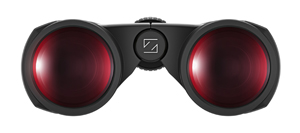
8x20, 8x32, 7x42, 8x42, 10x42, 10x26…Which are the right ones for me?
We are often asked questions about binoculars. For the inexperienced, finding a way through hundreds of models to the perfect pair for you can seem really daunting. We know the struggle - and we're here for you! After 35 years in the trade, we are able to provide all the useful tips and technical know-how to achieve your personal requirements. This page offers a thorough guide on the pros and cons of different binoculars regarding area of use, optical performance and general quality. If you have any questions, let us know promptly.
Different Magnifications
When you set out to find your new binoculars, the first thing to keep in mind is the magnification, ranging from 7x or 8x, 9x, 10x and finally 12x. This number simply reveals how many times closer the object will appear. The combination of the magnification and the size of the front lens plays a huge part in determining not only the size of the binoculars but how well they can be used in different situations. The diameter of the front lens in millimetres is given by the second number of the binoculars’ specification and should be taken into consideration as it tells you the brightness of the binoculars. A wider lens diameter simply makes room for more light to enter the front lens and hence increases the performance drastically in low-light conditions. To recap, a pair of binoculars with 8x magnification with a front lens diameter of 42 mm differ enormously from a pair with 10x magnification and a diameter of 25 mm. There is no saying which one of them is the better or worse pair of binoculars, as this depends on for what and at what time they are to be used. Understanding these major features and really pondering your personal preferences will help immensely in finding the most suitable pair of binoculars.
Pocket binoculars
As the name might suggest these are the smallest of all binoculars, weighing about 200-300 grams. For any activity where weight and size matter most, whether you are going camping, hiking, traveling, walking the dog or watching football, these binoculars are up for the job and can easily be kept in your jacket pocket or handbag. The magnification ranges between 8- 10 x and pocket binoculars offer lens diameters of 20-25mm. However, as the diameter is small, these binoculars do not perform as well in low light as larger and heavier models certainly would.
Compact Binoculars
If bright binoculars are of paramount importance to you, but you like the thought of a handy, small pair of binoculars to take everywhere, then the compact model binoculars are probably what will suit you best. They have a magnification of 8 or 10x and the front lens diameter typically ranges from 30-32 mm. A pair of binoculars like these will be your ideal companion in almost all weather and light conditions. Their features, combined with the low weight of 400-600 grams, have made them the binoculars of choice for more and more birdwatchers over the last two years - it is easy to see why. They are light enough to carry during a day in the field and provide a nice, wide field of view (especially the 8x30 models). With the 10x32 you will find yourself with a more limited field of view - but with the advantage of getting much closer to your subject.
HT – High Light transmission Binoculars
If the front lens diameter exceeds 40 mm – they are either called large binoculars or High light transmission binoculars. The magnification may vary from 7-12x but what they all have in common is superb performance in low light conditions. While most other binoculars struggle to perform at dusk or dawn you will find that binoculars with high light transmission are still able to produce great images, making them a favoured option for hunters and birdwatchers. If you spend a lot of time outdoors and don’t mind an extra kilo in weight, the large 50-56 mm lens binoculars are the most enjoyable in the range.
Quality
It is easy to assume that a larger pair of binoculars will be of better quality than a smaller pair. However, this is rarely the case. Occasionally we encounter pocket binoculars with way brighter optics than standard models. This depends on how good the quality of the glass is in the lenses – how well the lenses have been cut and treated during the manufacturing process. Binoculars equipped with fluorite crystal glass will also further reduce colour-blur effectively in hard daylight and give a higher contrast and a slightly brighter touch to the viewing experience. The thin metal layer that the lenses are treated with, the coating, varies greatly between cheaper and more expensive models. Remember to take into consideration that the mechanics and quality of optics always differ between brands and within price levels.
If you have any questions, or wish to know more about a specific pair of binoculars in our webshop, contact us on phone +46 0485 444 40 or our mail info@naturbokhandeln.se.